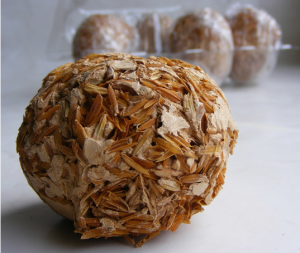
Pictured after the jump (because while this stuff doesn’t bother me, I may be in the minority here) is something called a “Century Egg”, which I’ve heard mentioned from time to time, particularly in reference to congee mix-ins (according to some, congee isn’t complete without the addition of one of these).
A Century Egg, also called a “Hundred-Year Egg,” a “Preserved Egg,” a “Thousand-Year Egg,” and (lovely) a “Horse Urine Egg,” is an egg that has been preserved in a mixture of clay, lime, ash, salt, and rice hulls for several weeks (sometimes several months). Like this:
According to legend, the Century Egg was discovered during the Ming Dynasty by a man who returned to his home, which had been under construction for several months, only to discover a few duck eggs that had been buried in quicklime. He ate them, either out of adventurousness or extreme hunger, and an odd, fascinating tradition was born.
It apparently smells very, very sulfurous – with hints of ammonia – and should not be eaten on its own, or in large quantities (sort of the same way you wouldn’t take an enormous bite of very pungent blue cheese). Justcookit describes it as follows: “If you took an x-ray of a raw egg, asked a three year old to colour it in and took a photograph of the result, the negative of that photo would look similar to a thousand year egg.” It’s best eaten in small portions mixed into relatively bland foods (such as the aforementioned congee), or with the addition of strong spices (such as chiles).
Incidentally, I appreciate – and second – this blog’s statement that “the foods of other cultures [shouldn’t be used for] shock value in [our] own culture.” So let me be clear: while some may see this as “disgusting,” for many, many people worldwide the taste of a Century Egg is remarkable, unique…even comforting.
I’m sort of dying to try one.
…Sort of.
Images via Odditycentral.



